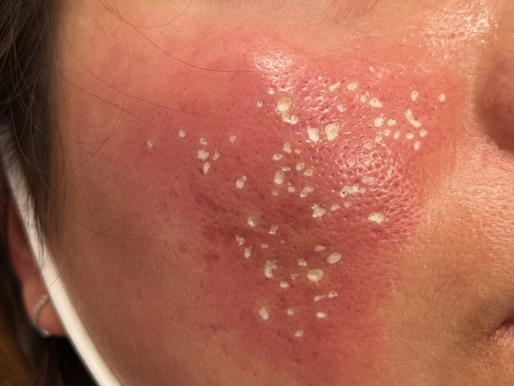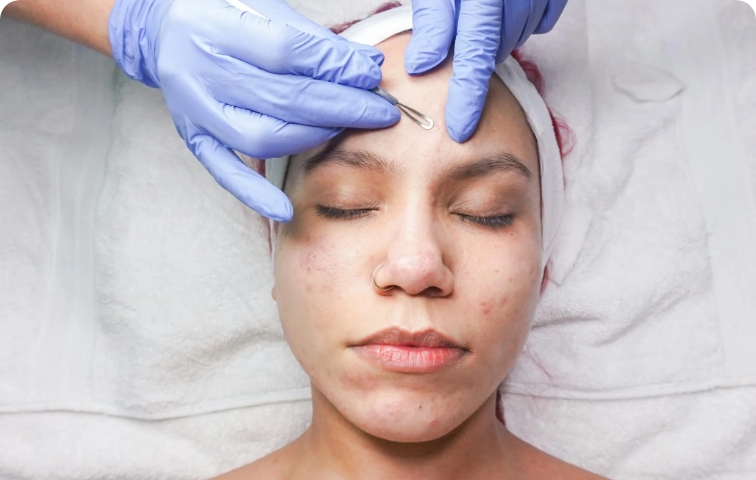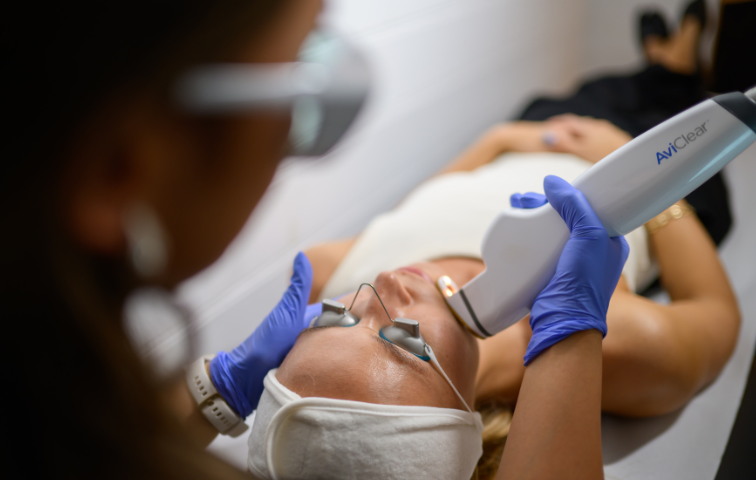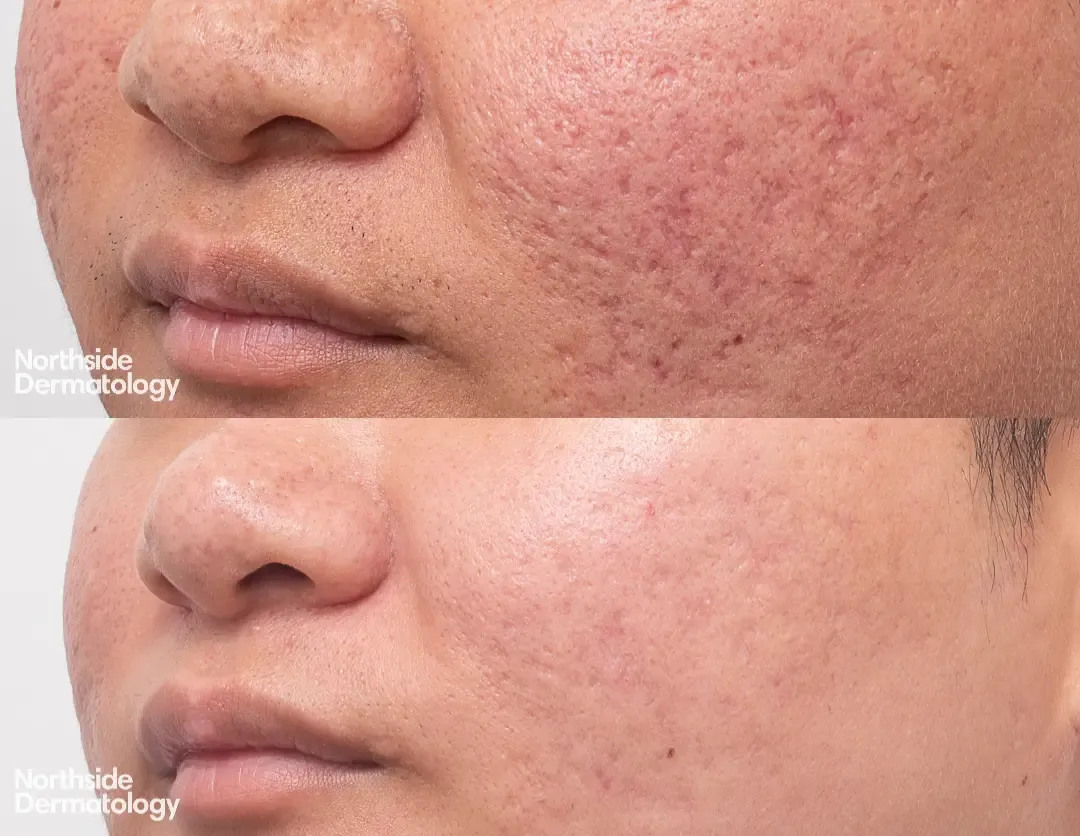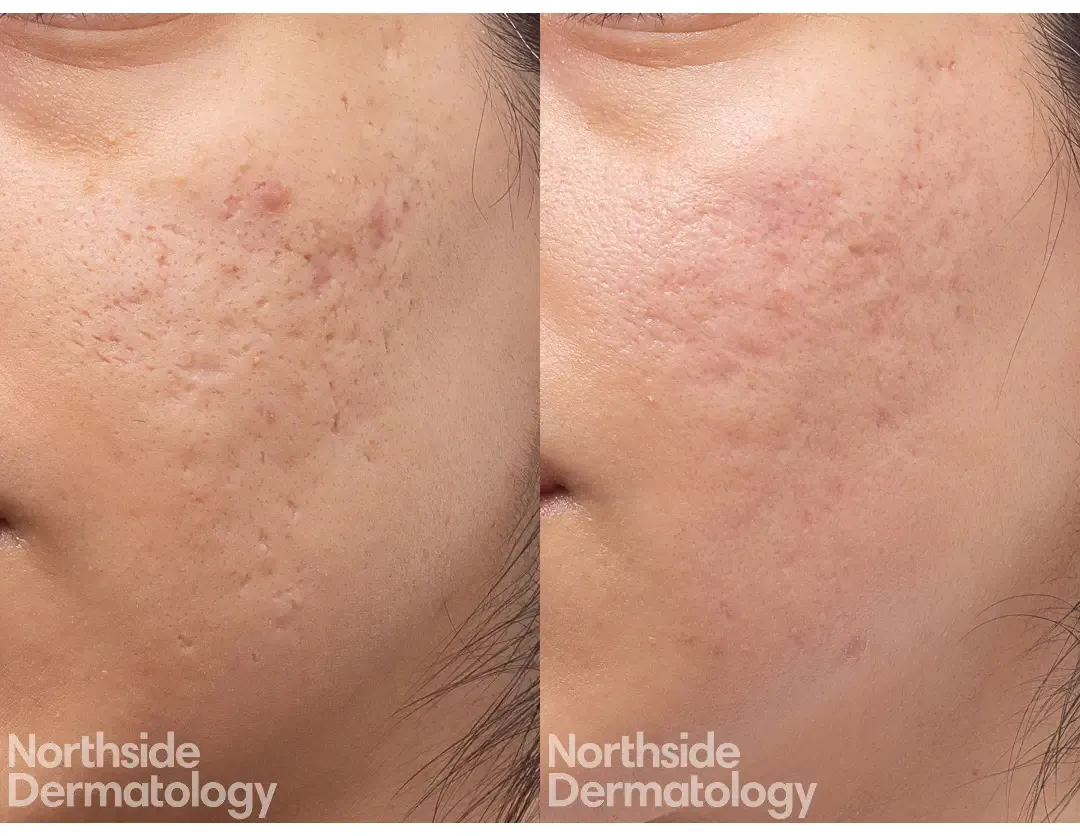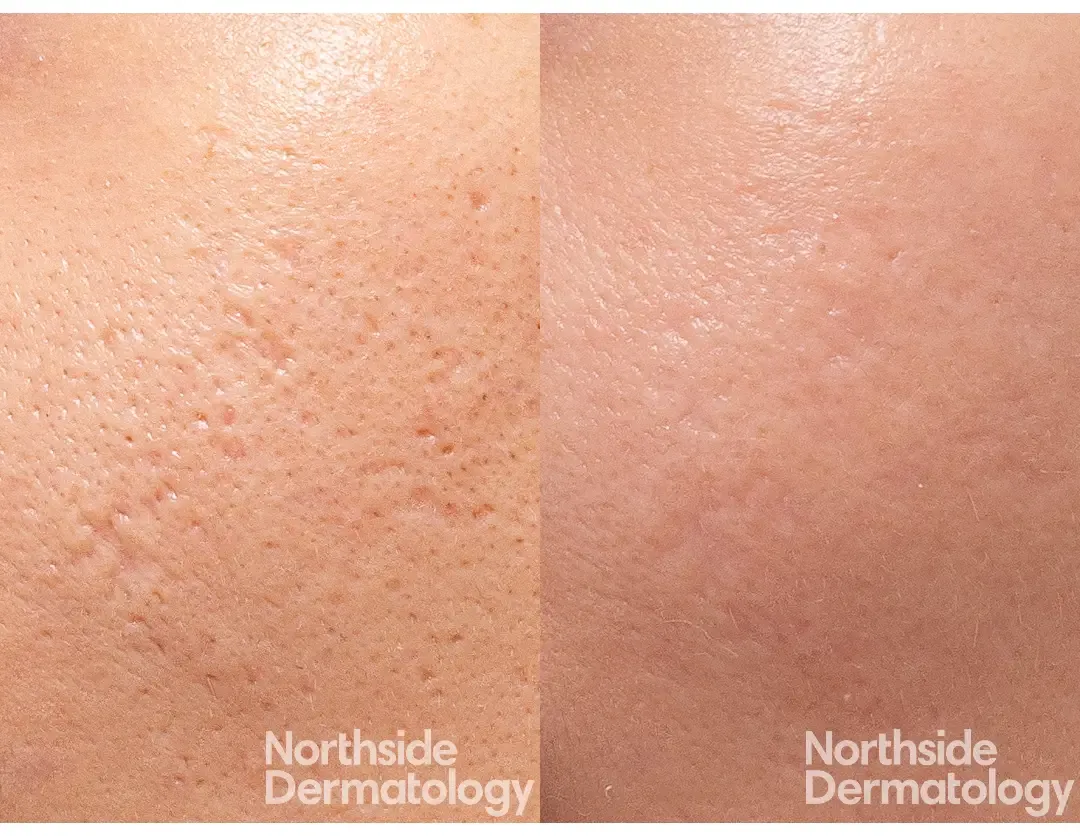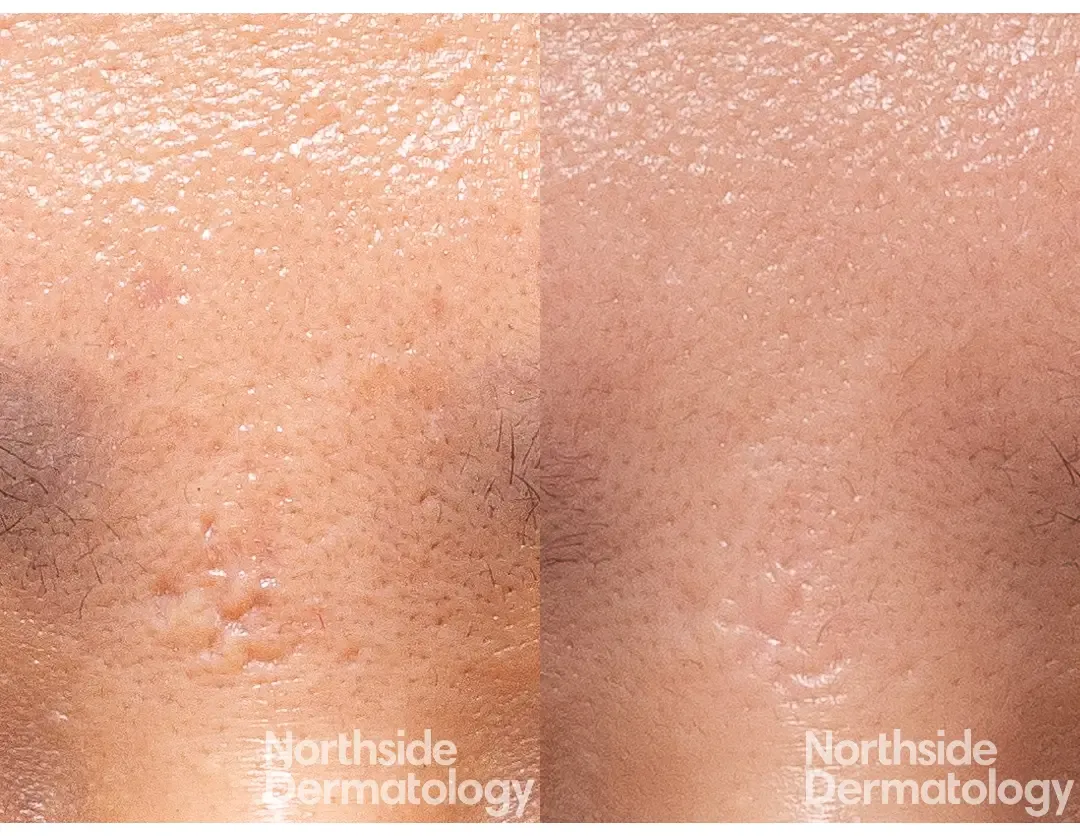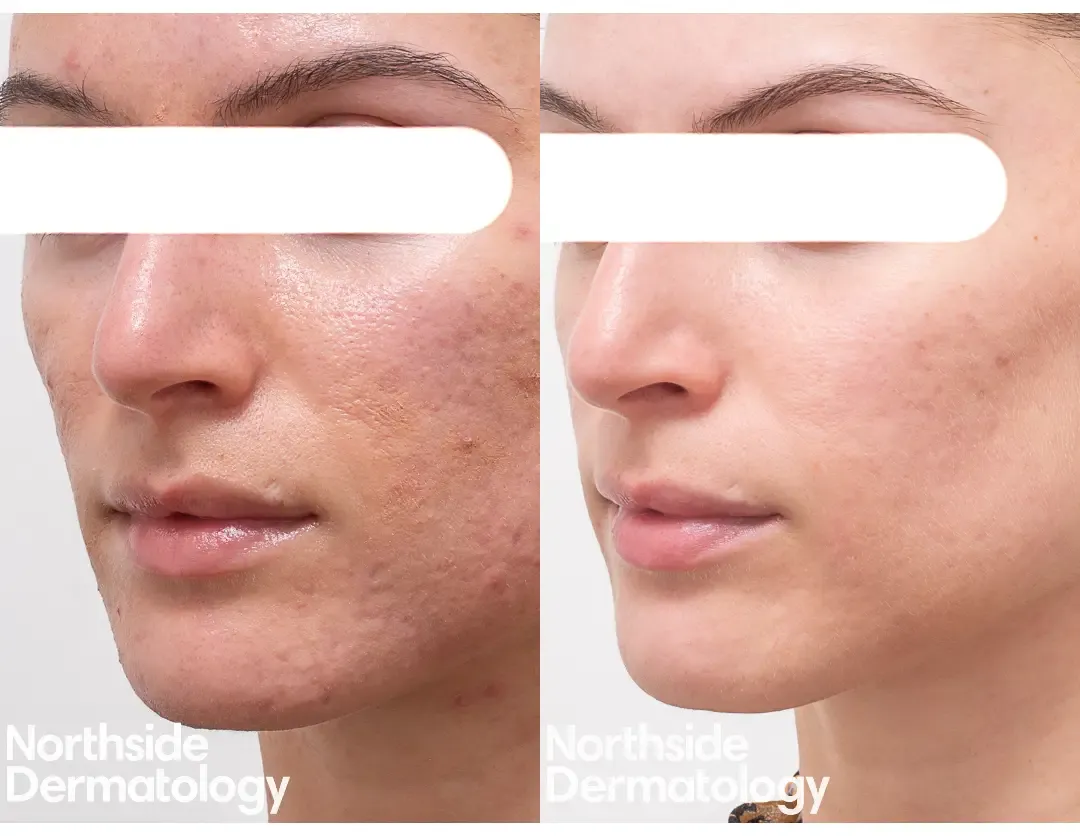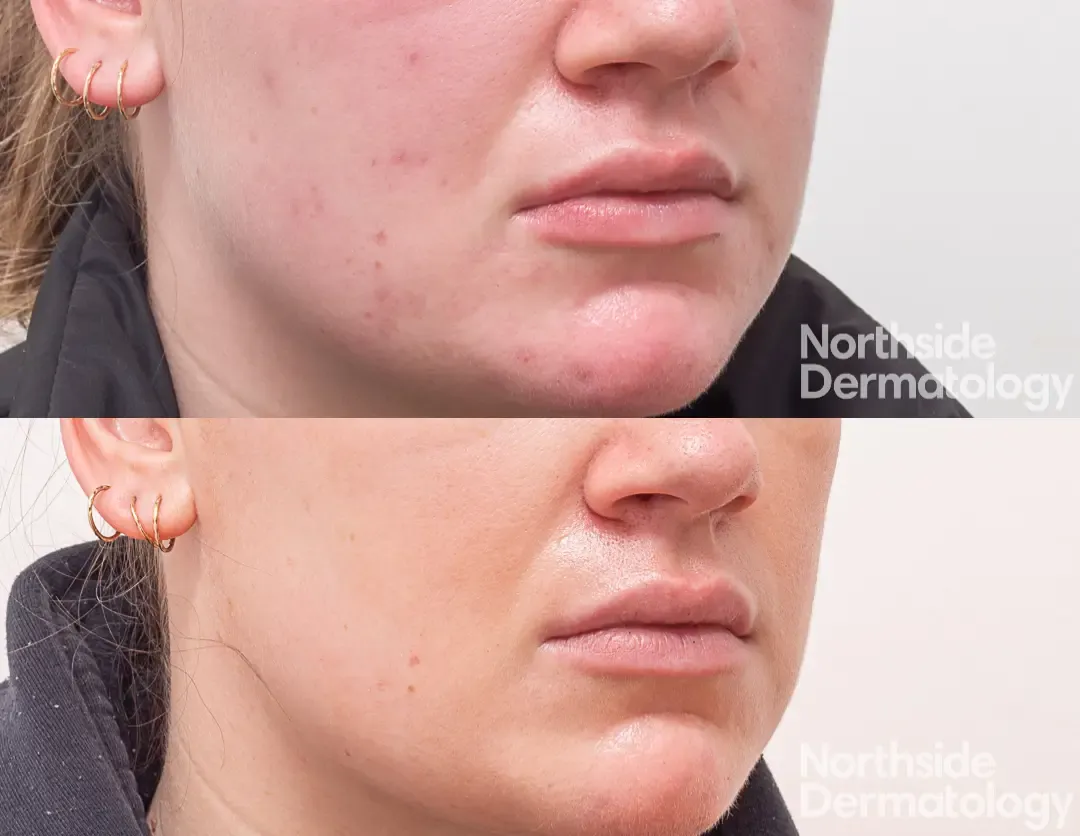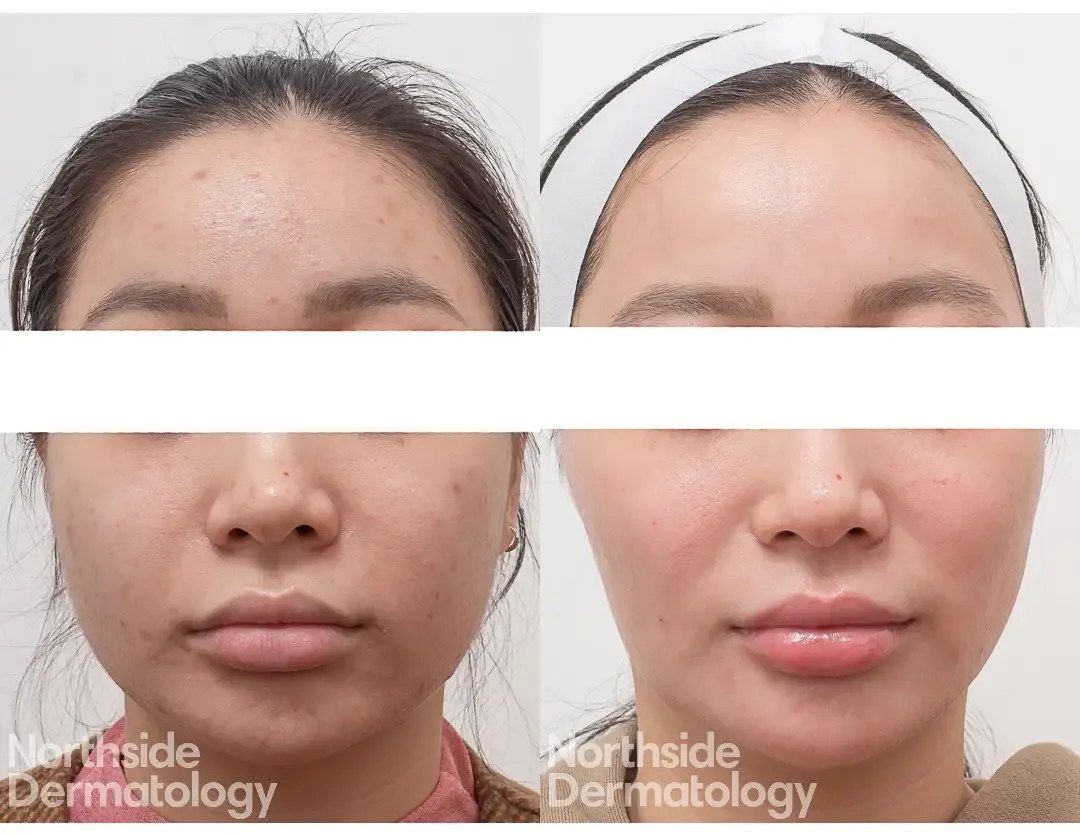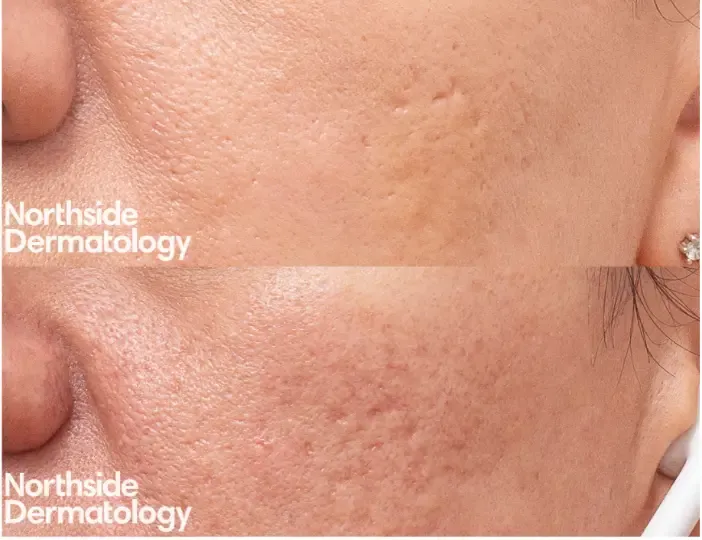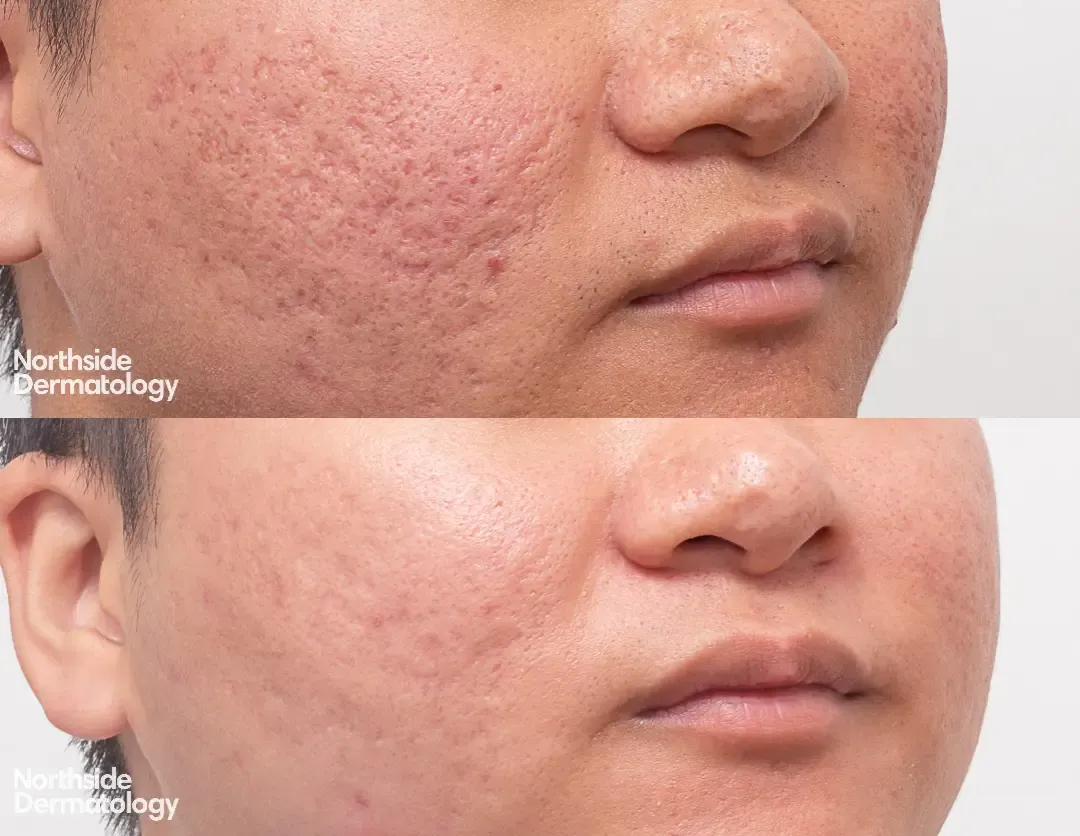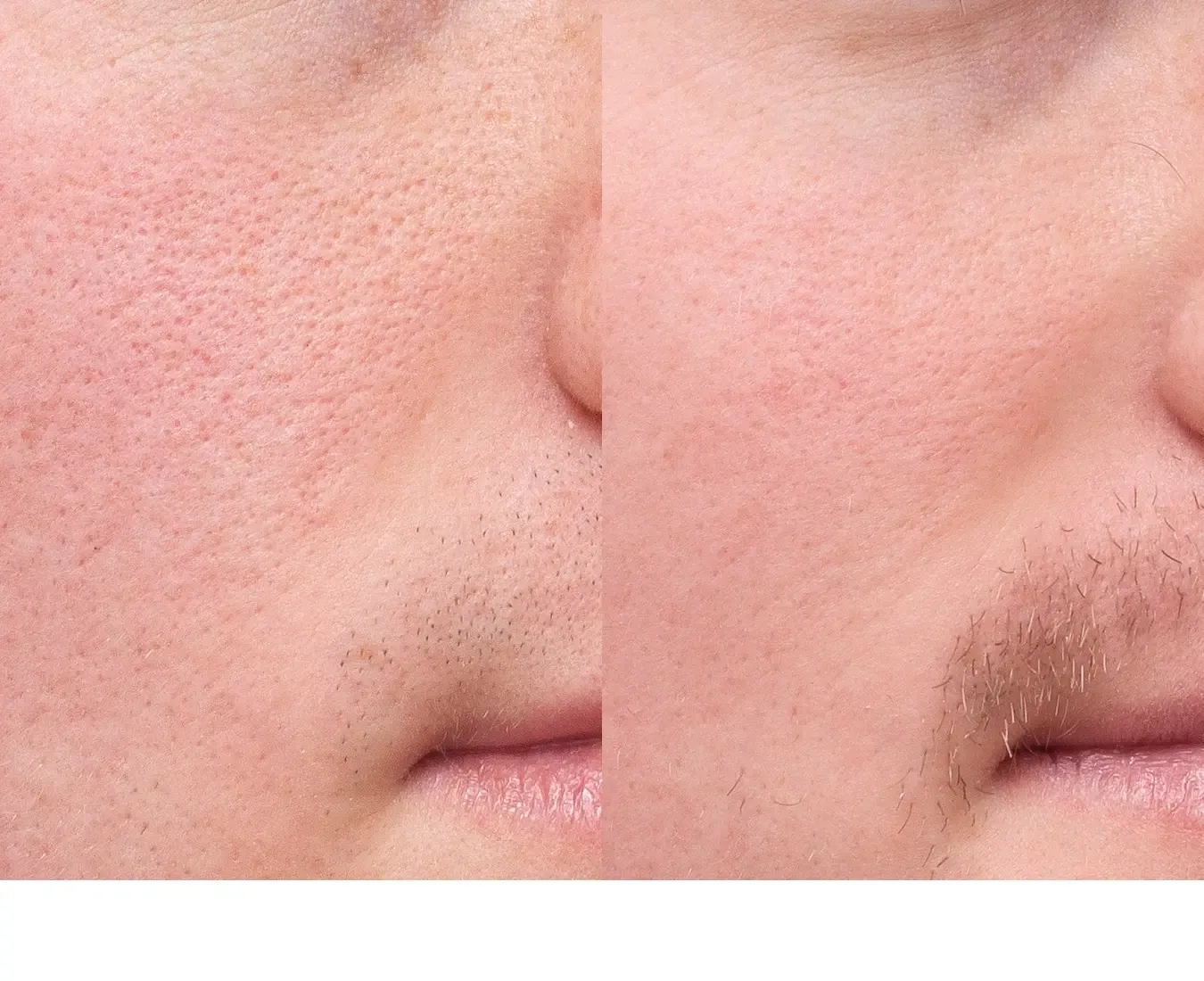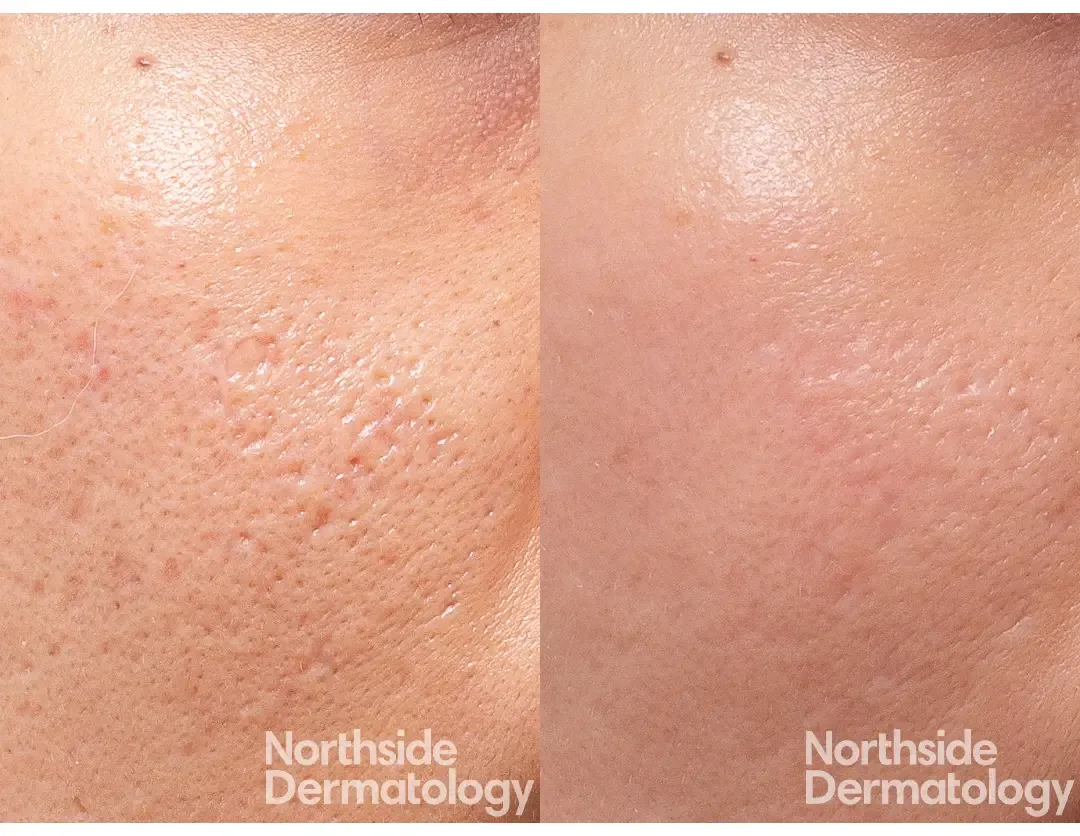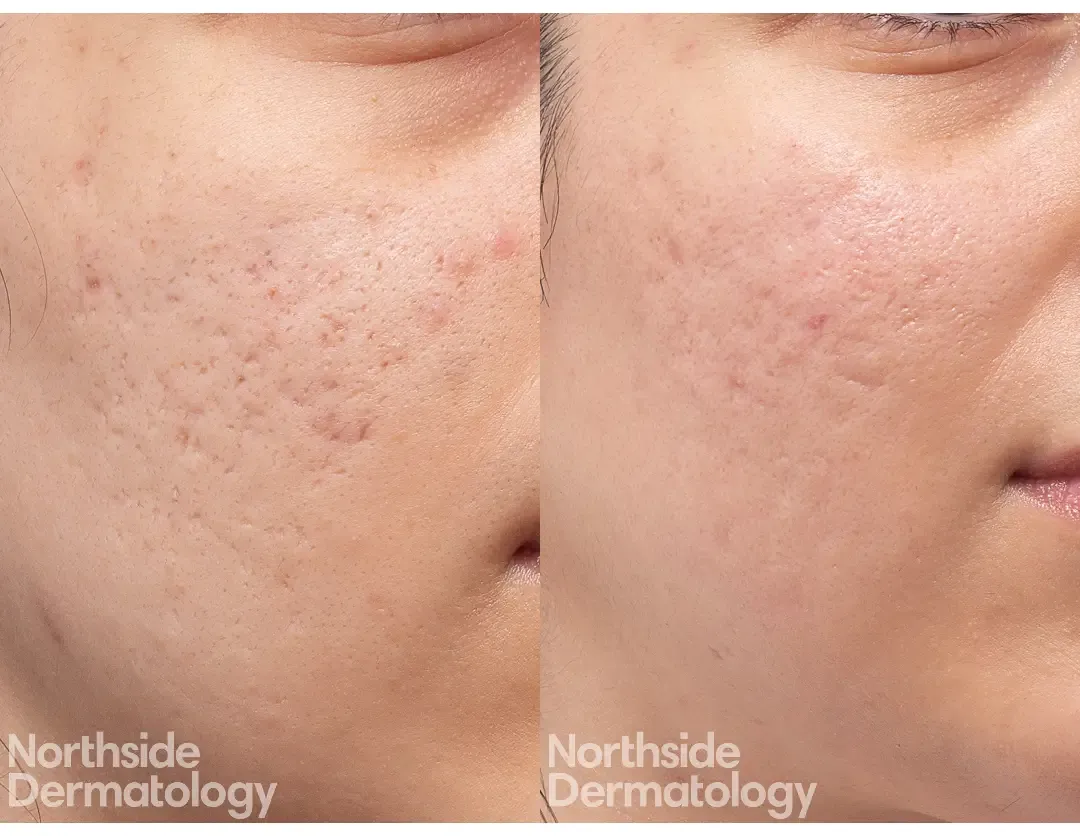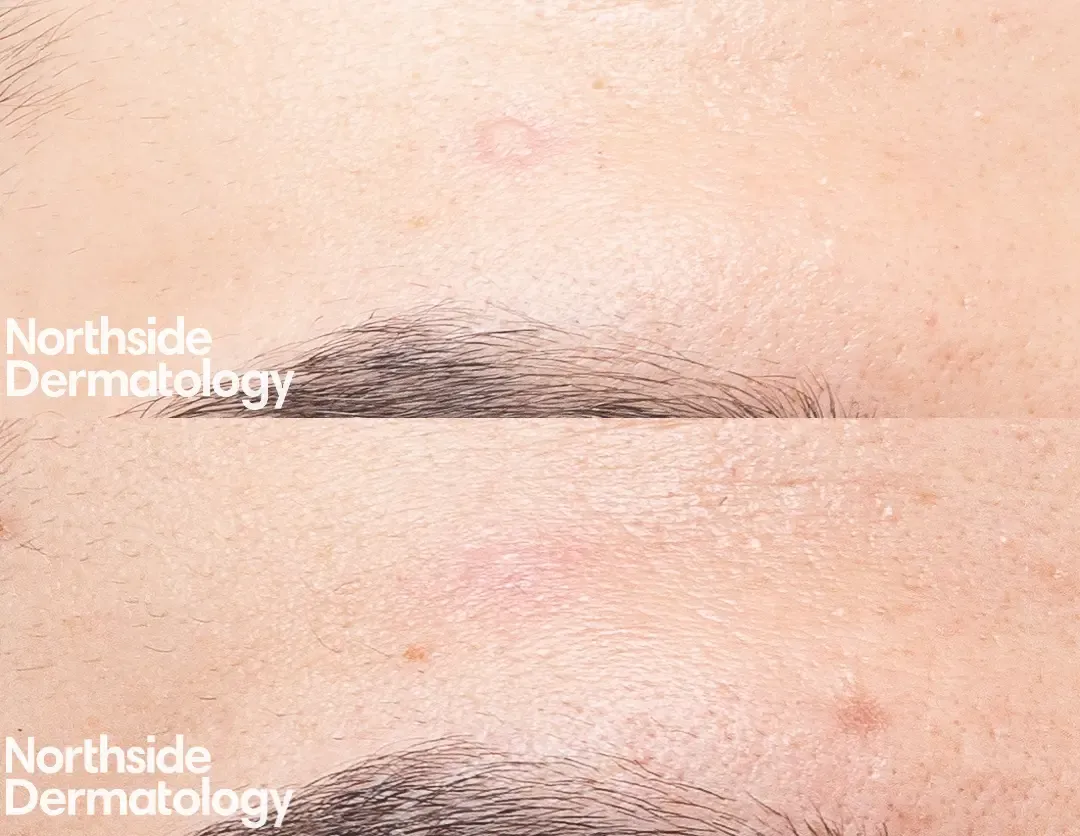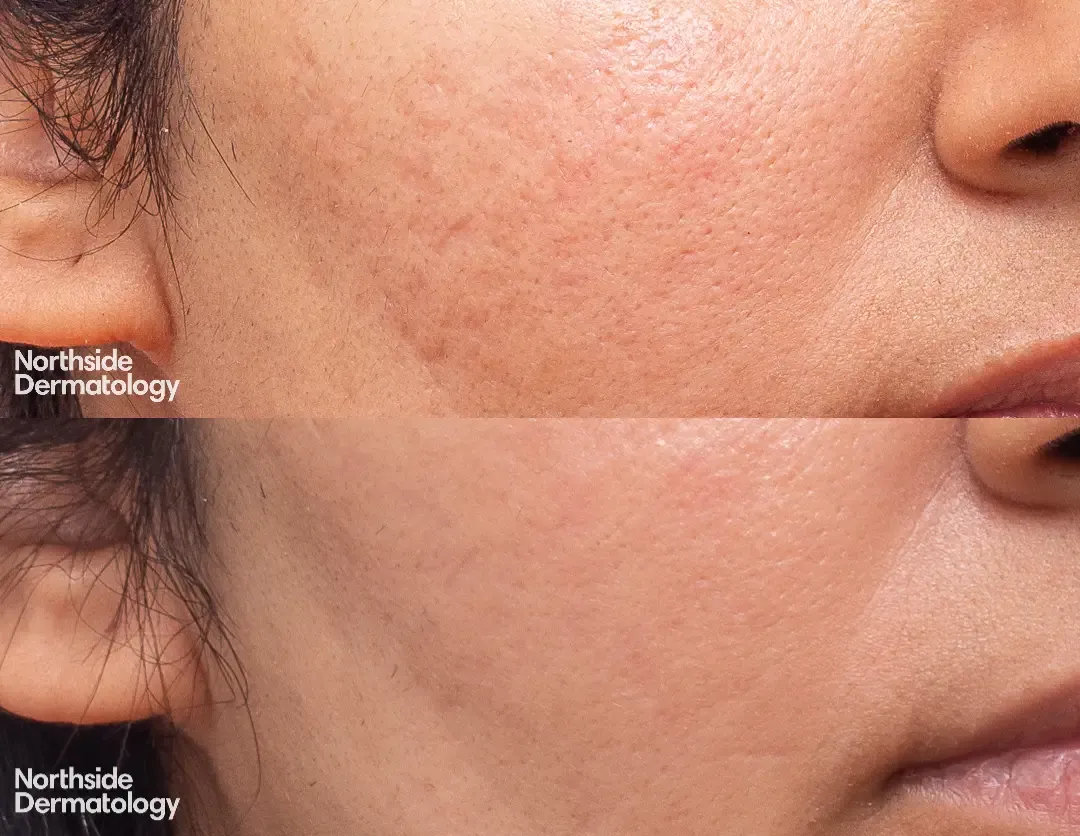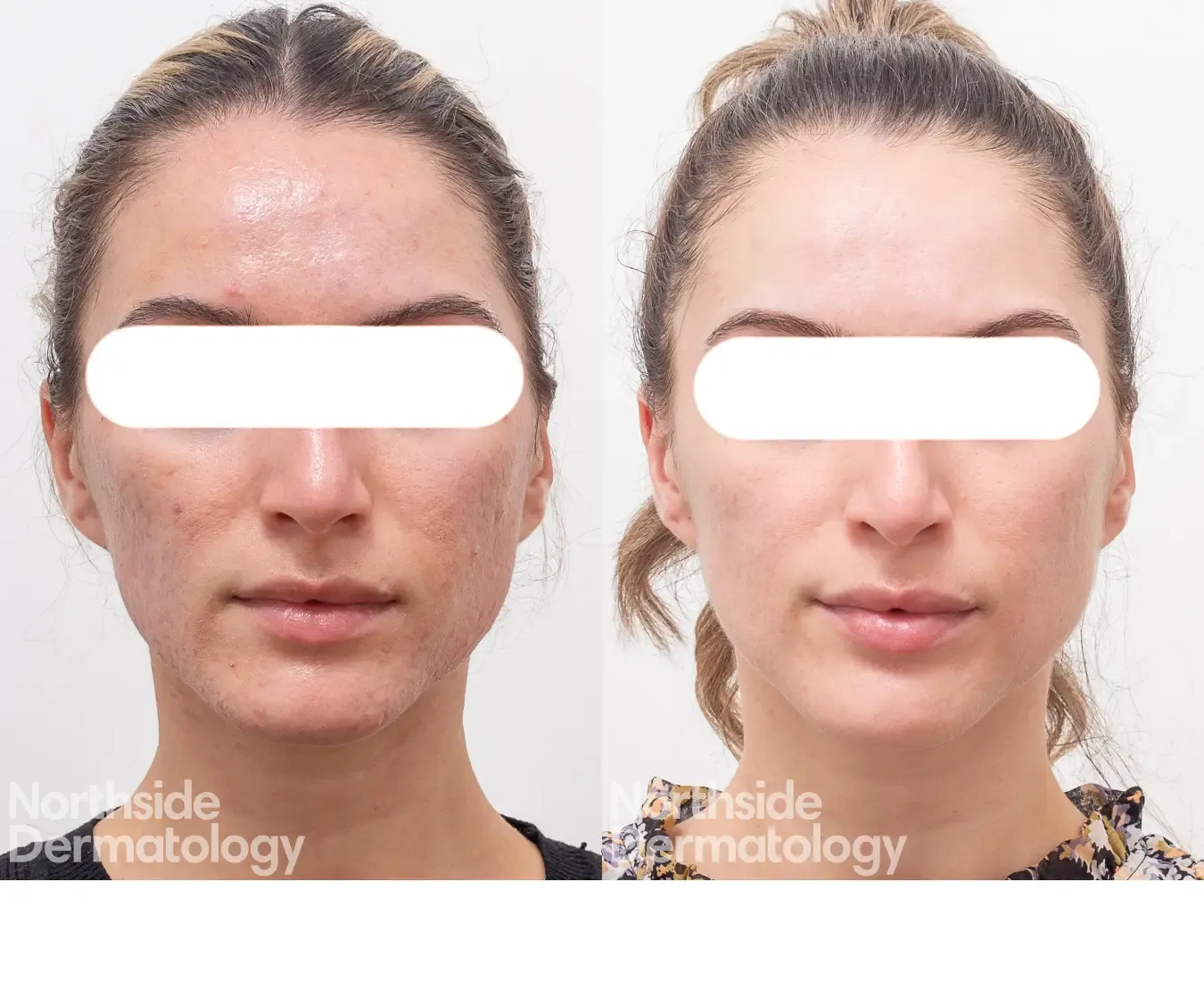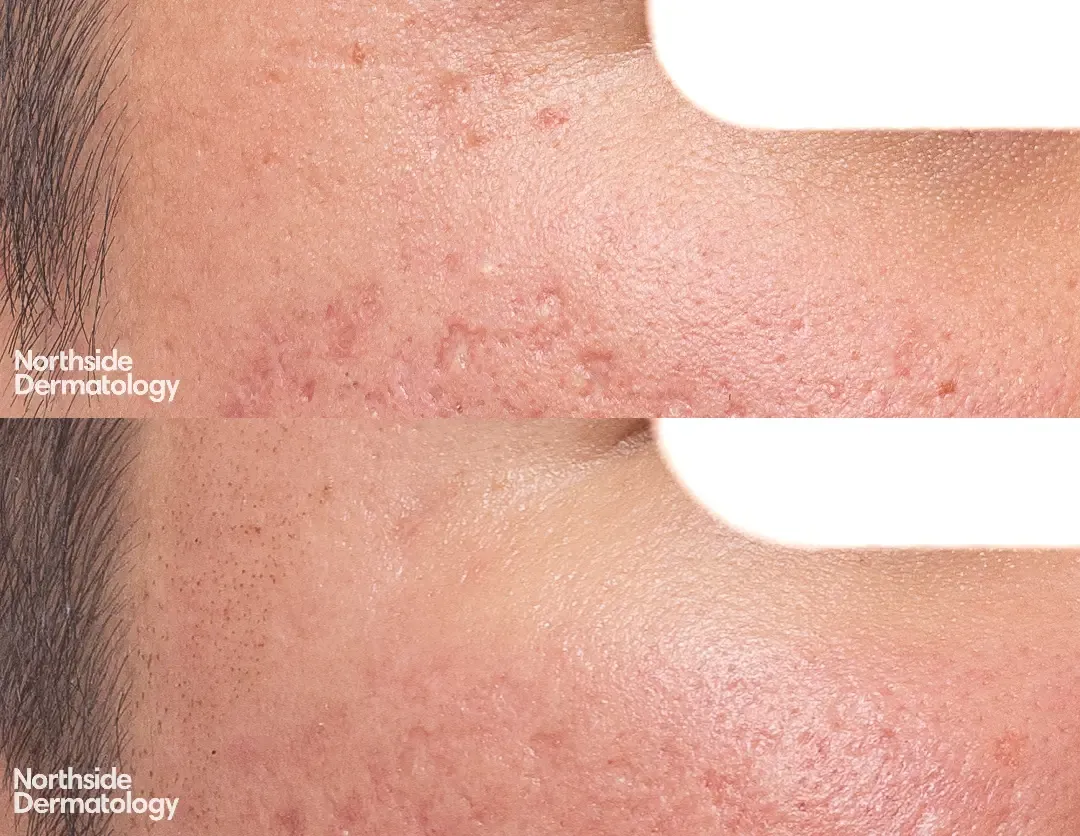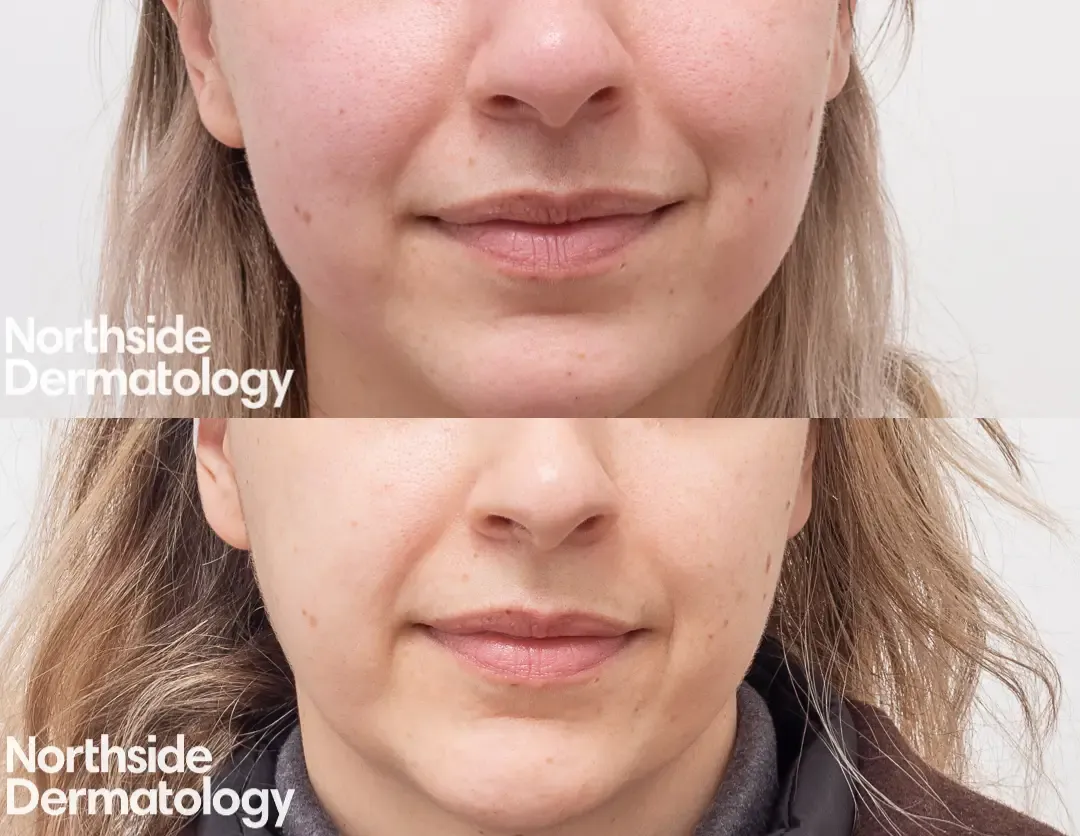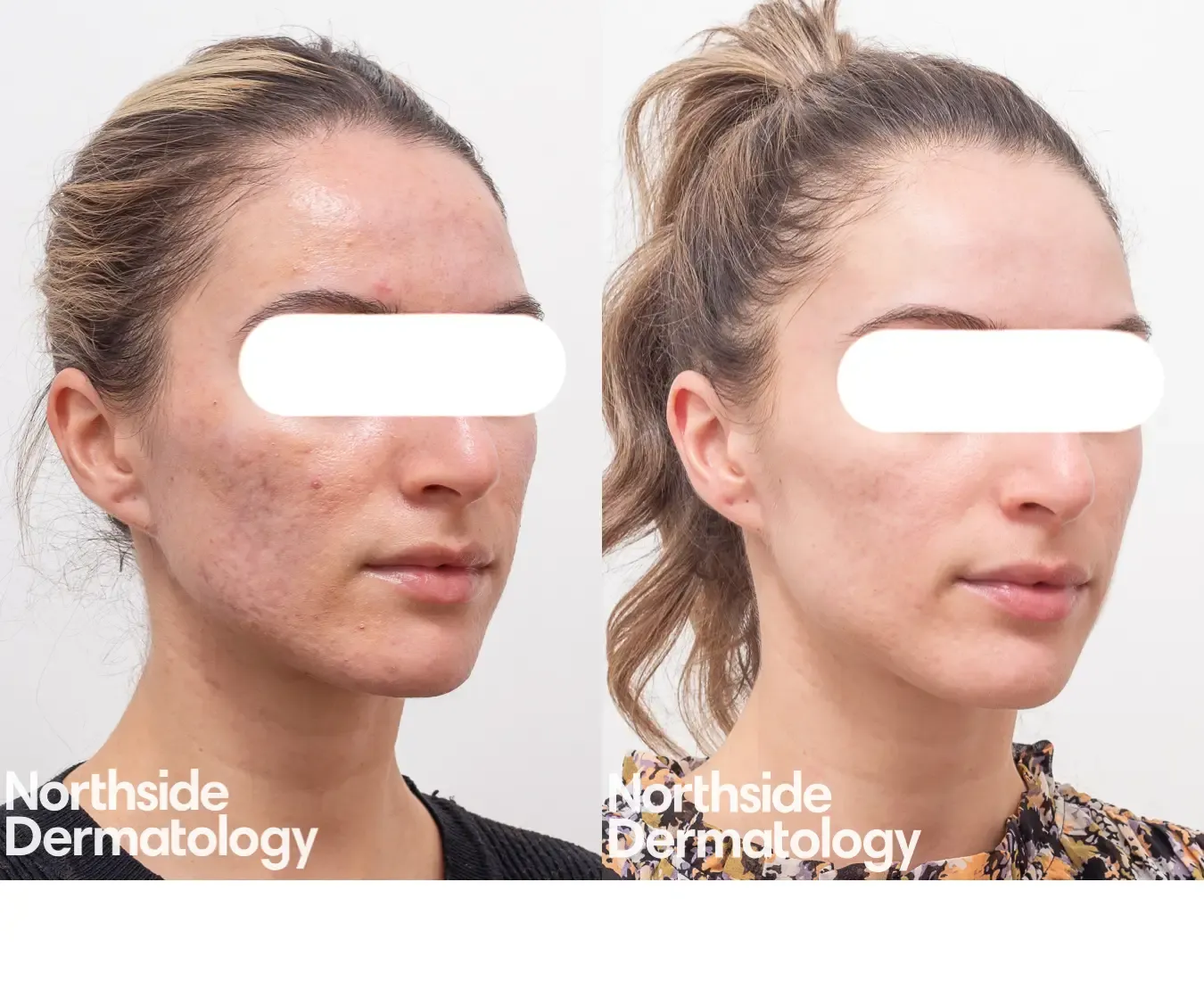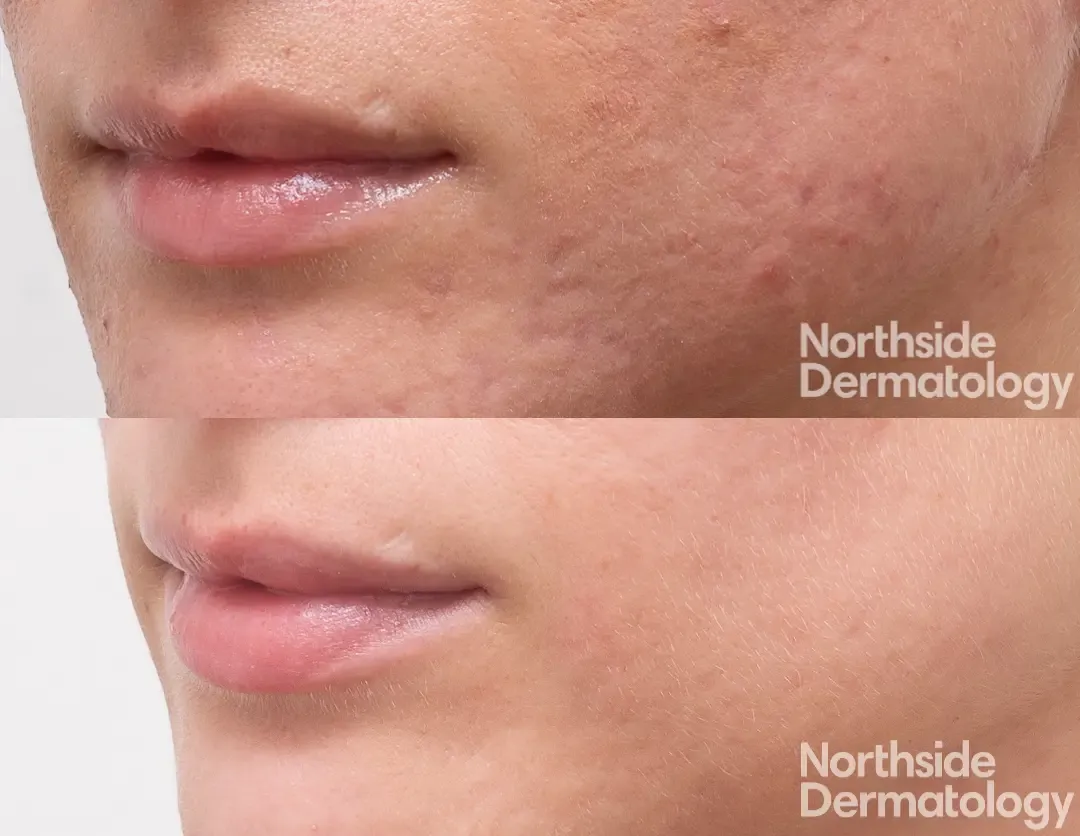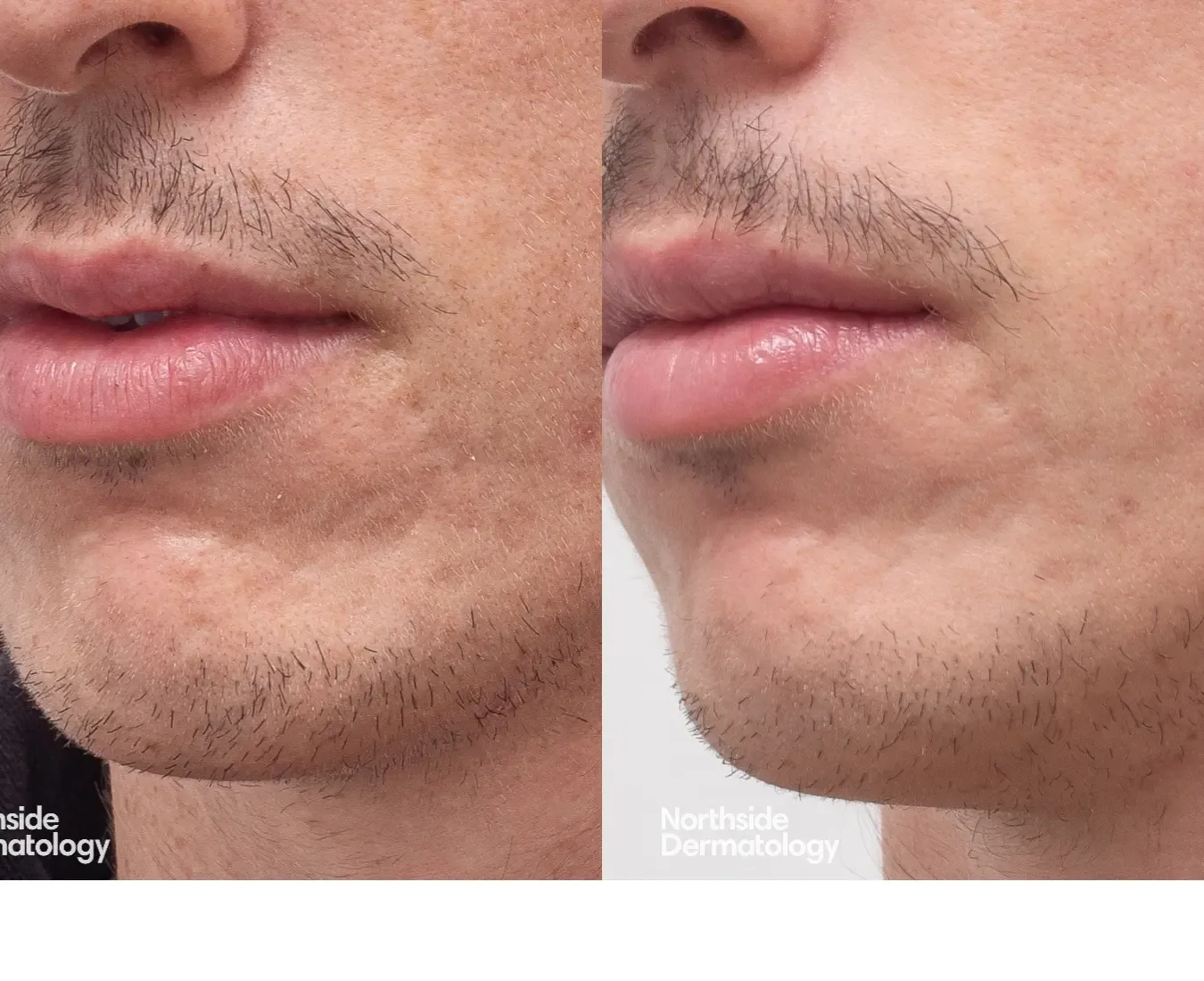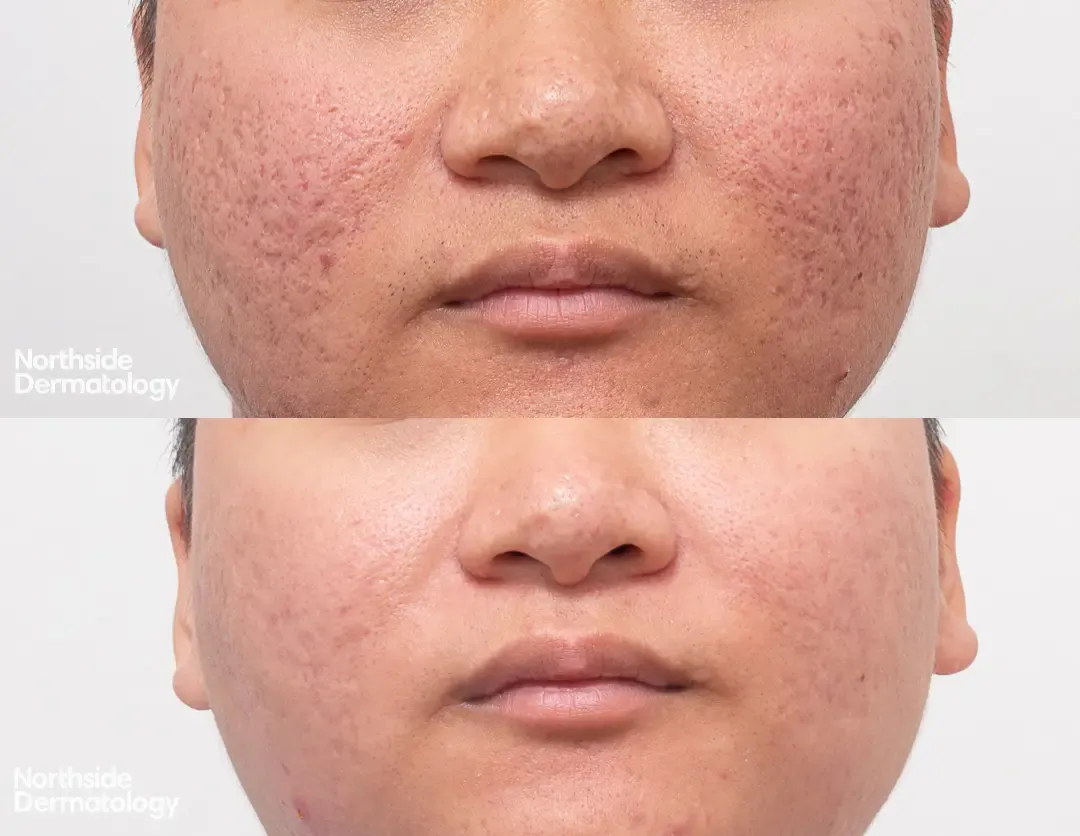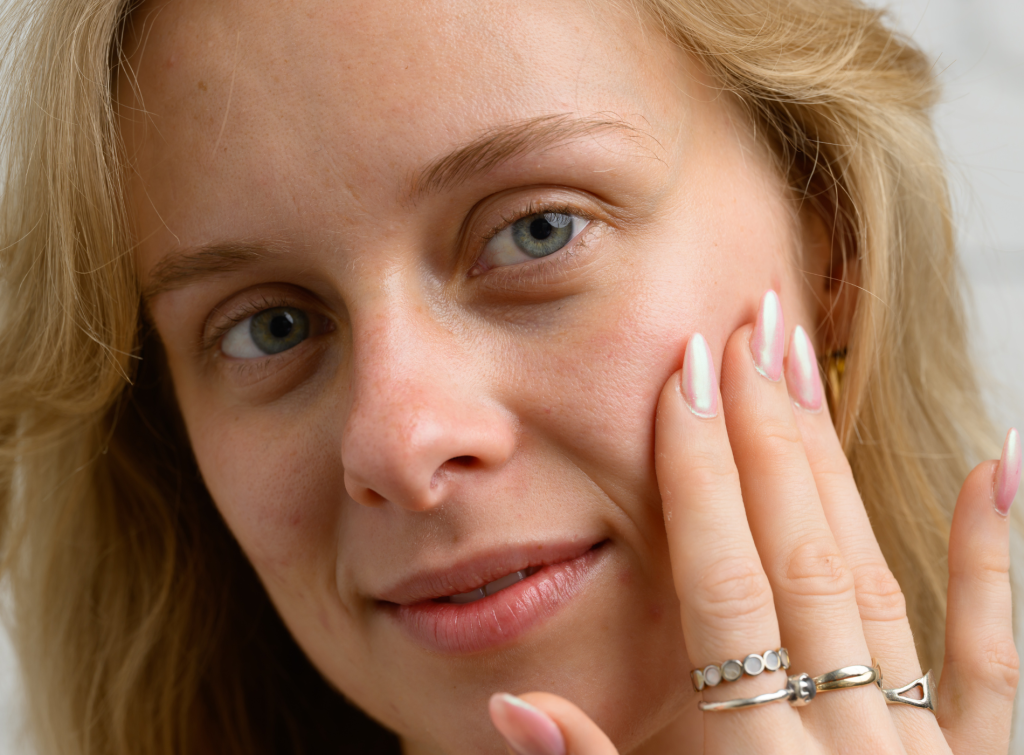
What are Acne Scars?
Acne scars form when inflammation from a breakout damages the deeper layers of the skin. The body attempts to heal this damage by producing collagen, but if it makes too much or too little, a scar develops. These marks can remain long after the acne itself clears, often appearing as indentations, raised bumps or discolouration.
While acne scars can be stubborn, effective treatment is possible. Most patients require a customised combination of therapies to address different scar types and skin concerns. That’s why expert assessment is essential.
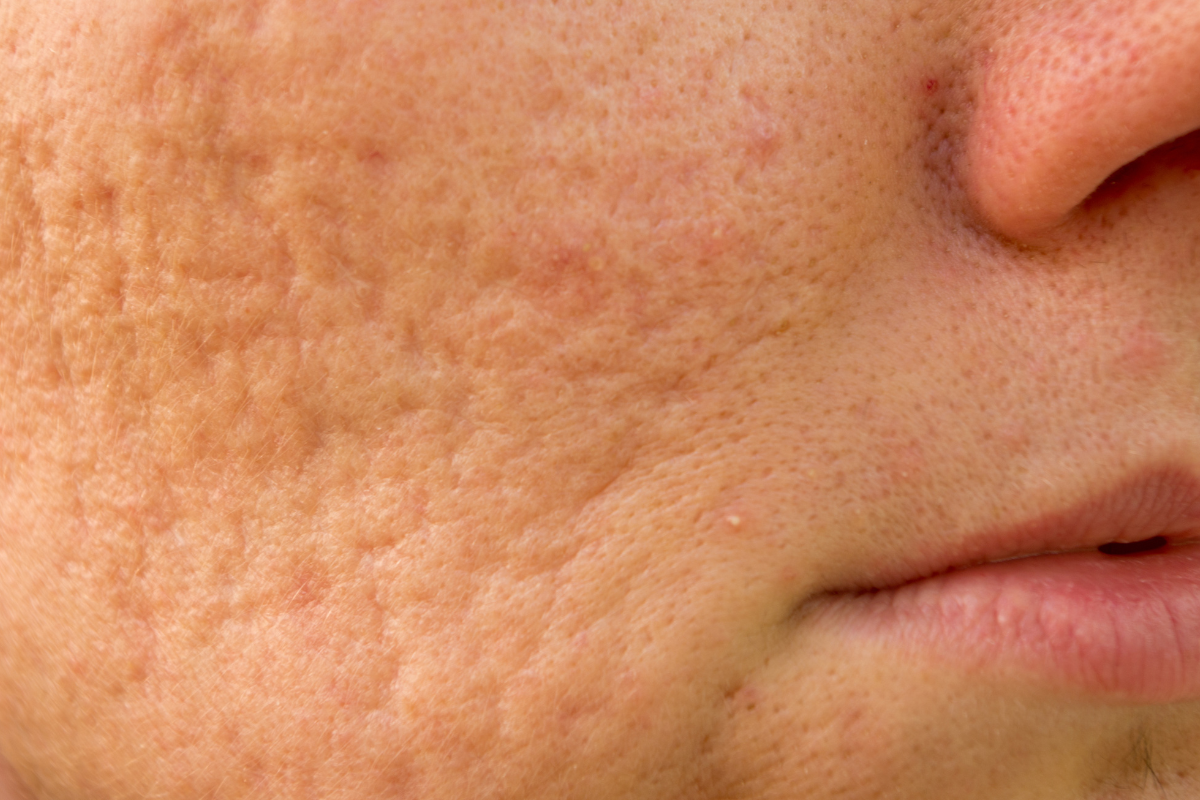
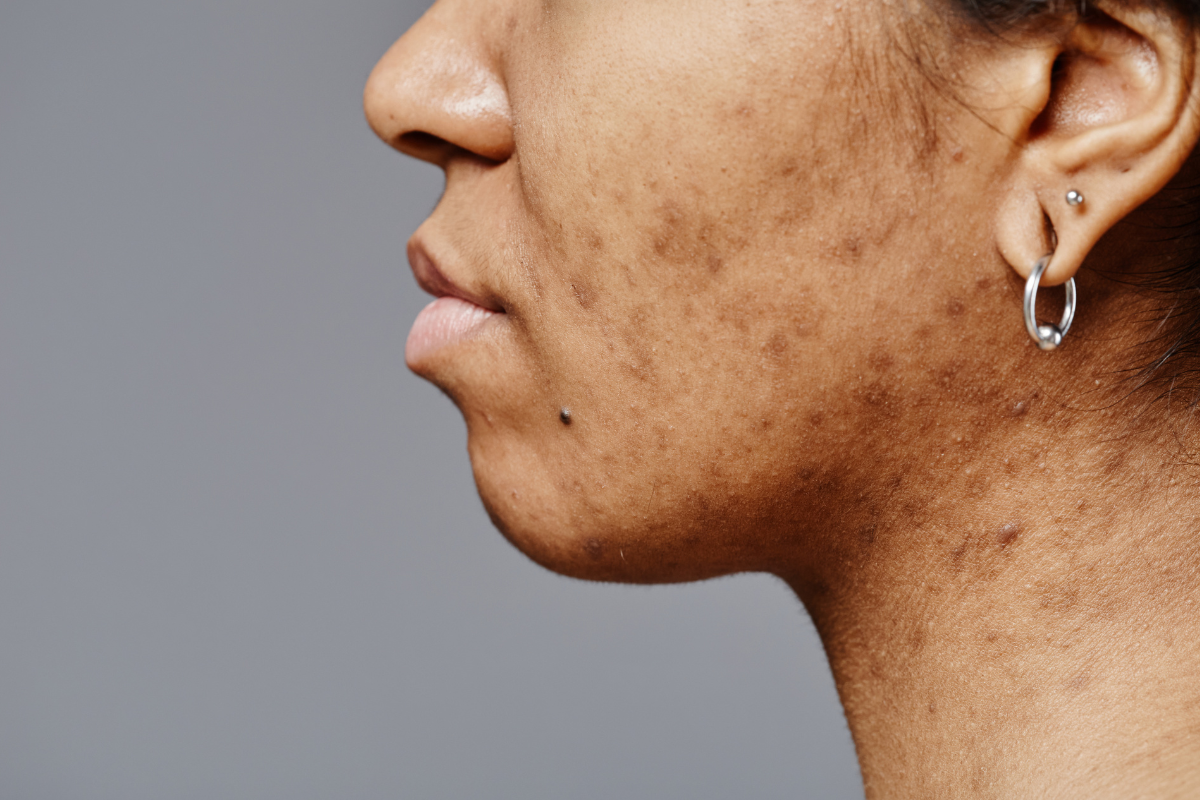
Types Of Acne Scars
Acne scars fall into two main categories: Depressed (atrophic) scars, which form dents in the skin, and raised (hypertrophic) scars, which appear thick or bumpy.
Within these groups are several common subtypes:
-
Ice Pick Scars: Deep and narrow, like small punctures.
Best treated with: TCA CROSS, punch excision, CO2 laser. -
Boxcar Scars: Broad depressions with sharply defined edges.
Best treated with: TCA CROSS, punch elevation, CO2 laser, dermal fillers. -
Rolling Scars: Wide depressions with sloping edges that cause skin to look uneven.
Best treated with: Subcision, nanofractional RF, CO2 laser, fillers. -
Hypertrophic Scars: Raised and thick, often lumpy.
Best treated with: Intralesional steroid injections, nerve-blocking injections, vascular lasers, resurfacing lasers, laser-assisted topical delivery. -
Red Scars: Often flat or slightly indented.
Best treated with: Vascular laser, Laser Genesis, nanofractional RF. -
Pigmented Scars: Brown or discoloured marks.
Best treated with: Peels, pigment-inhibiting creams, Q-switched laser, gentle resurfacing laser. -
Hypopigmented Scars: White, lacking pigment.
Best treated with: Resurfacing laser + pigment-stimulating medication (challenging but possible).
Acne Scar Treatments
A holistic approach to acne scarring is supported at Northside Dermatology, with dermatologists who consult at the clinic offering treatment plans that may include prescription therapies, in-clinic procedures, and evidence-based skincare to help manage and minimise scarring.
TCA CROSS
Subcision Treatment
CO2 Laser
Nanofractional Laser
Before and After
View GalleryFrequently asked questions
Acne scars fall into two broad categories. Depressed scars create a pit or dent in the skin. Raised scars project upward from the skin’s surface. Within those categories, there are several common types of acne scars:
- Ice Pick Scars: deep, narrow, pitted scars. These are best treated with TCA CROSS, punch excision or Co2 laser.
- Boxcar Scars: broad depressions with sharply defined edges. These are suitable for TCA CROSS, punch elevation, Co2 laser and dermal fillers.
- Atrophic and Rolling Scars: broad depressions with gently sloping edges. These are treated wtih subcision, nanofractional resurfacing RF, fractional co2 laser and dermal fillers.
- Hypertrophic Scars: thick, raised, lumpy scars. These scars are treated with intralesional injections (steroid and nerve-ending blockers) and sometimes vascular +/- resurfacing laser +/- laser-assisted medication delivery.
- Red slightly depressed scars can be treated with vascular laser or nanofractional RF.
- Pigmented scars can be treated with peels, pigment-inhibiting creams, Q-switched laser and superficial resurfacing laser.
- Hypopigmented scars: scars that are white and lack in pigmentation. These tend to be challenging to treat. The dermatologists use resurfacing laser in combination with pigment stimulating medication.
TCA CROSS stands for ‘TriChloroacetic Acid Chemical Reconstruction Of Skin Scars’. During the procedure, a specialist dermatologist applies a small amount of high-concentration TCA directly to the scar. A chemical reaction occurs, causing a localised inflammatory response that leads to the formation of new collagen fibres that change the appearance of the scar. The treated areas initially turn white, then become red and undergo a crusting phase. Recovery is expected within three to seven days. The collagen formation process continues gradually over the course of multiple TCA CROSS treatments until a good result is achieved. TCA CROSS is ideal for treating deep ice pick scars.
Subcision is a surgical technique used to treat depressed acne scars. A specialist dermatologist performs the procedure by inserting a special needle into the skin and using it to separate the thickened scar tissue from the underlying tissue. This allows the skin to return to its normal position and stimulates collagen growth, leading to cosmetic improvement of the scar. Subcision is a minor procedure that can be safely performed in an outpatient setting under local anaesthetic . Most established, advanced acne scars can benefit from this underutilised technique.
TCA CROSS and subcision are just two of many modalities available to treat acne scarring. Other options include:
- Radiofrequency Treatment: an energy-based device associated with little downtime that stimulates collagen remodelling to treat rolling scars; suitable for both light and dark skin types
- Laser Resurfacing: treatment with fractional CO2 laser and or 1927nm thulium laser that removes damaged cells and stimulates collagen production; used for more advanced scarring
- Punch Elevation: a procedure in which the scar is lifted to match the surface level of the skin, making it less noticeable; best for boxcar scars with sharp edges
- Punch Excision: a minimally invasive technique that excises the scar using a small punch tool; ideal for deep ice pick scars and narrow, deep boxcar scars
- Intralesional Injections: an intralesional steroid or 5-fluorouracil injection administered directly into a hypertrophic scar to break down excess collagen and prevent further collagen growth
- Laser Genesis: a non-ablative laser that delivers short pulses of laser energy to promote collagen production and reduce redness; recommended for red atrophic scars
- Vascular Laser: a laser that improves red marks left behind by old acne lesions; recommended for predominantly red scars
- Pigment Laser: a laser that specifically targets post inflammatory pigmentation that is left by acne.
- Dermal Fillers: dermal fillers can be injected into the scarred area to fill in an indented scar and create a smoother surface; recommended for persistent depressed scars
- Skin Needling: a gentle, lower cost treatment that stimulates the body’s natural healing and collagen production processes by using ultrafine needles to create tiny wounds in the skin; effective for subtle scars and scars in the early stages of development
- Prescription Topical Cream: topical prescription treatments that can improve acne scarring include retinoids (derived from vitamin A), pigment lightening cream and steroid cream
- Silicone Gels: application of medical-grade silicone products can help flatten and soften raised scars by increasing hydration and regulating collagen synthesis
- Sun Protection: fresh scar tissue is delicate and vulnerable to a condition called post-inflammatory hyperpigmentation; use sunscreen and protective clothing to keep new scars shielded from UV exposure.
For patients seeking acne scar treatment with minimal downtime, dermatologists who consult at Northside Dermatology may recommend options such as radio frequency treatment, Laser Genesis, vascular laser, or skin needling. These procedures are typically well tolerated and involve straightforward post-treatment care.
Side effects are generally mild and may include temporary redness or sensitivity. Most individuals are able to resume normal activities shortly after treatment, depending on the specific modality used and individual response.
Laser treatments are not right for every patient or every scar. It’s critical to undergo assessment by a professional to determine the best option for your circumstances. Your treatment must be tailored to your individual scars, and different scars may require different approaches. Your specialist dermatologist may recommend subcision for one scar and TCA CROSS for another, followed by radiofrequency treatment and dermal fillers to achieve optimal results. Every scar is different.
The first step to treating acne scars is to be examined by a specialist dermatologist with extensive experience in scar identification and management. They will assess your skin to determine what types of acne scars you have, the severity of your scarring and the best course of treatment for each scar type. Most people have a combination of types that require a blend of treatment modalities over a period of time to achieve the best possible result.


